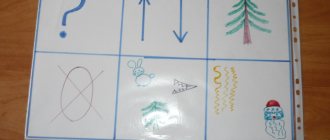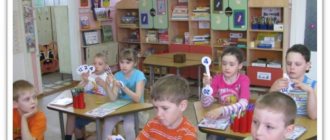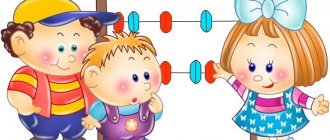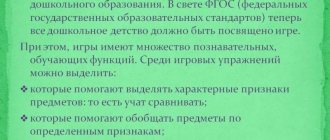Modern technologies for mathematical development of preschool childrenpresentation
Slide 1
Modern technologies for mathematical development of preschool children
Slide 2
In recent years, the term “technology” has been increasingly used in the theory and practice of preschool education. In relation to the methods of mathematical development of preschoolers, they talk about technologies of teaching, mathematical development, technologies for the development of quantitative concepts in preschoolers, technologies for logical-mathematical development and training of preschoolers.
Slide 3
A characteristic feature of the technology is its clear structuring and algorithmization, which is understood as the identification of sequential procedures and operations, united by the internal logic of the functioning and development of a given process.
Slide 4
Modern technologies for the mathematical development of preschoolers are aimed at: activating the child’s cognitive activity, the child’s mastery of the connections and dependencies of objects and phenomena in the surrounding world.
Slide 5
PROBLEM - GAME TECHNOLOGY. One of the most effective technologies, close to the child in its essence. It is based on the child’s active, conscious search for a way to achieve a result based on his acceptance of the goal of the activity and independent reflection on upcoming practical actions leading to the result. The goal is to develop children’s cognitive and creative abilities in logical and mathematical activities.
Slide 6
PROBLEM-BASED GAME TECHNOLOGY allows the child to: master the means (sensory standards, speech, diagrams and models) and methods of cognition (comparison, examination, classification, seriation), accumulate logical and mathematical experience.
Slide 7
PROBLEM - GAME TECHNOLOGY At work. Mikhailova Z. A. is presented in the system of the following means: logical and mathematical games; logical and mathematical story games (activities); problematic situations and questions; creative tasks, questions and situations; experimentation and research activities.
Slide 8
2. Plot-based logical-mathematical game. Nosova E.A. A set of such games and exercises has been developed (“Help the ants”, “Find the treasure”, “Have settled in the houses”, “Who is visiting Winnie the Pooh and Piglet”), which are presented in the book “Logic and Mathematics in Kindergarten”. The author divided all the games into groups: games to identify and abstract the properties of objects; games for children to master comparison, classification and generalization; games for mastering logical actions and mental operations.
Slide 9
This technology can be represented by successive steps: from mastering the game in joint activities of an adult and a child to participation in games at the amateur level; transition to participation in games at a higher level; newly emerging games of an adult with children or children successfully playing them (distinguished by a changed plot, a transformed course of the game)
Slide 10
3. Creative tasks, questions and situations. help the child: establish various connections, identify cause by effect, and most importantly, the child begins to experience pleasure from mental work, from the thinking process, from awareness of his own capabilities.
Slide 11
4. A problem situation is considered as: a means of mastering search actions, the ability to formulate one’s own thoughts about search methods and the expected result. (entertaining tasks, joke tasks that make children think and establish connections between objects by shape, ratio of parts, their location in space, quantitative value).
Slide 12
5. Experimentation and research activities. The main way to develop a child’s investigative behavior is through his own research practice. Carried out in children's experimentation, during which children master: actions of measuring, combining, transforming various materials and substances; conservation principle; get acquainted with instruments (thermometer, scales, mirror, magnet, etc.); learn to use educational books as a source of information. (when comparing the weight of dry and wet sand, children notice that wet sand is heavier. After additional questions from the teacher, the children formulate the conclusion: “There is water in wet sand, so it is heavier”).
Slide 13
Experimentation and research activities. results of research activities: new information about the object under study, its properties, qualities, structure, connections with other objects (about geometric shapes, quantities, different methods of measurement, number dependencies); new information about another (additional) object under study (about simple instruments for measuring lengths; about the reflection of objects in water, a mirror; the action of a magnet); knowledge about research methods and its results (about simple experiments, experiments, making assumptions, the need for variation when choosing methods for organizing research, evaluating the result and forecasting further research).
Slide 14
TRIZ TECHNOLOGY It is based not just on teaching children mathematics, but on discovering ways to obtain the correct result. Problem situations are part of TRIZ technology. The authors propose to identify problematic situations from cartoons, feature films, educational Internet, fairy tales, short stories, and plot games that are well known to the child (the contradiction in K. Chukovsky’s work “Fedorino’s Grief”: leave the dishes for Fedora so that she can cook and eat food or deprive her of the dishes for bad treatment?). According to TRIZ theory, you need to “turn harm into benefit.”
Slide 15
TRIZ TECHNOLOGY For the mathematical development of children, it is recommended to use the following types of TRIZ exercises: “Search for common features” - find as many common features as possible in two different objects; “The third odd one” - take three objects that are different along the semantic axis, find in two of them similar features that are not in the third; “Search for opposite objects” - name the object and as many objects opposite it as possible.
Slide 16
TRIZ TECHNOLOGY Along with TRIZ exercises, technology offers special games compiled by the teacher based on plots known to children, such as: “Good-bad” (a triangle is chosen as the object, it is necessary to name all the good things that are connected in people’s lives with the triangle: it looks like a roof at home, stable, looks like a scarf; and everything is bad: sharp, doesn’t roll, falls over). “Choose three” (it is proposed to name three words related to mathematics and tell what they are for and how they can interact; - “circle”, “four”, “small” - in the game you can use four circles as plates for dolls) . “Yes and no” (the teacher thinks of a word, and the children solve it by asking questions so that the teacher can only answer “yes” or “no.”).
Slide 17
HEURISTIC TECHNOLOGY The essence of heuristic technology (G.A. Repin) is to immerse the child in the situation of a discoverer. The child is invited to discover knowledge unknown to him. The purpose of the technology is to help the child open channels of communication with the world of mathematics and understand its features.
Slide 18
HEURISTIC TECHNOLOGY The authors of heuristic technology recommend using cognitive and creative (creative) methods. Cognitive methods include: the method of assimilation, the method of heuristic questions, the method of errors, etc. - Methods of assimilation - “feeling”, “instilling” of the child into the state of the object being studied, “humanizing” the object through sensory-figurative and mental representations and knowing it from the inside. (imagine that you are the number 5 (conventional measure, triangle, cylinder). What are you? Why do you exist? Who are your friends? What are you made of? What do you like to do?) - Heuristic questions - allow the child to obtain information about the object being studied (Who? What? Why? Where? With what? How? When?), which provide an opportunity for an unusual vision of the object. — The error method is the use of errors to deepen the educational process. The method helps to overcome the teacher’s negative attitude towards children’s mistakes and the children’s fear of making a mistake. (For example, when a child incorrectly claims that 4 is less than 3, ask the question: can it really be that 4 is less than 3. Yes, it can if we are talking about 4 days and 3 weeks.)
Slide 19
HEURISTIC TECHNOLOGY Creative methods include methods of inventing, hyperbolizing, brainstorming, and the synectics method. — The method of inventing is to create a previously unknown product as a result of using mental modeling techniques: replacing one quality with another, finding the properties of an object in another environment. For example, draw a city with inhabitants - fabulous numbers. — The hyperbolization method involves increasing or decreasing the object being studied and its individual parts or qualities in order to identify its essence. For example, think of a polygon with the most angles. — Agglutination is a combination of qualities, parts of objects that are incompatible in real life. For example, the top of an abyss, an empty set.
Slide 20
HEURISTIC TECHNOLOGY The brainstorming method is very popular at the present stage. The situation of introducing brainstorming can arise spontaneously when solving any cognitive problem, during a game-activity. The teacher can invite the children to put forward any solutions to the problem, successful or unsuccessful. Ideas can be written down. (For example, how to rescue a bead from “ice captivity” (a bead in an ice cube)? Ideas: cut through the ice! Hold it in your hands and the ice cube will melt.) The teacher accepts any ideas without emotional and rational evaluation. Children come to conclusions themselves based on analysis, after all the ideas have been expressed.
Slide 21
INFORMATION TECHNOLOGY Today, information technologies affect all spheres of life, serve the general and personal interests of a person, and are aimed at revealing his potential. The computer provides new gaming and learning opportunities for preschool children.
Slide 22
INFORMATION TECHNOLOGIES Currently, at the Research Institute of Preschool Education, in the Russian Federation, the theoretical foundations for the use of scientific information technologies in the educational system of preschool educational institutions are being developed. Several series of programs for preschoolers have already been created, which, depending on the pedagogical focus, are divided into groups: - Educational (of a subject nature) - mathematics, native language, music..., the content and course of the games presented in them are clearly outlined. — Developmental — they encourage children to engage in creative independent play and communication with peers (children themselves look for ways to solve game problems, are free to choose plots and means for conveying them. — Diagnostic — they allow you to identify the level of certain skills, abilities, interests of the child. In a certain In a sense, any computer program can be considered developmental if it helps improve perception, memory, imagination, and thinking.
Slide 23
TECHNOLOGY OF THE ACTIVITY METHOD “SITUATION” (Lyudmila Georgievna Peterson) The activity approach is such an organization of the educational process in which the child masters culture not by simply transmitting information, but in the PROCESS OF HIS OWN ACTIVITY.
Slide 24
Technology “SITUATION” Includes 6 successive stages: Introduction to the situation; Updating knowledge and skills; Difficulty in the situation; “Discovery” of new knowledge; Inclusion of new knowledge (method of action) into the system of knowledge and skills; Understanding.
Slide 25
1. Introduction to the situation Problems solved in the joint activities of adults and children: Creating conditions for children to develop an internal need to be included in activities, formulating by children the so-called “children’s” goal.
Slide 26
2. Updating knowledge and skills Problems solved in joint activities of adults and children: Organization of cognitive activity in which mental operations are purposefully updated, as well as the knowledge and experience of children necessary for them to “discover” new knowledge.
Slide 27
3. Difficulty in a situation Tasks solved in the joint activity of an adult and children: Facing a difficulty, analyzing the situation that has arisen: fixing the difficulty, identifying its cause (lack of knowledge, familiar methods of action). “COULD YOU? WHY CAN’T YOU?”
Slide 28
4. “Discovery” of new knowledge Problems solved in joint activities of adults and children: Choosing a way to overcome difficulties, putting forward and justifying hypotheses. Determining the order of actions. Implementation of the plan is the search and “discovery of new knowledge (methods of action) through the use of various forms of organization of children’s activities, ensuring, on the one hand, overcoming difficulties (achieving a “children’s” goal, and on the other hand, solving program tasks of teaching education, development (“adult” "goal). Fixation of new knowledge (mode of action) in speech and, possibly, symbolically. “What should you do if you don’t know something, but really want to know?”, “How can we find out?)
Slide 29
5. Inclusion of new knowledge (method of action) into the system of knowledge and skills Problems solved in joint activities of adults and children: Using new knowledge (method of action) together with previously mastered methods, with speaking out loud the algorithm, method. Self-test using a sample and (or) mutual test (if planned). Using new knowledge (methods of action) in joint activities: work in pairs, micro-groups (if planned). What will you do now? ? How will you complete the task? Where do you start? How will you know that you have completed the task correctly?
Slide 30
6. Comprehension of the tasks solved in the joint activities of adults and children: Children’s recording of the achievement of a “children’s” goal. Talking through the teacher (in the junior and middle groups) or children (in the senior or preparatory group for school) of the conditions that made it possible to achieve this goal. Emphasis on successful experience in overcoming difficulties through identifying and eliminating their causes. “Where were you?”, “What were you doing?”, “Who did you help?” — the teacher helps children comprehend their activities and record the achievement of the “children’s” goal. And then, with the help of questions: “How did you succeed?”, “What did you do to achieve the goal?”, “What knowledge (skills, personal qualities) were useful to you?” - leads children to the fact that they achieved a “children’s” goal due to the fact that they learned something, learned something, showed themselves in a certain way, that is, brings together the “children’s” and “adult” goals (“Succeeded ..., because they found out (learned)...").
Slide 31
THANK YOU FOR YOUR ATTENTION
The importance of developing mathematical concepts in children
Definition 1
Mathematical concepts are elementary knowledge about size, shape, space, time, quantity, their relationships and properties, necessary for the successful development of scientific and everyday concepts in a child.
Children's mathematical concepts are formed through the process of organized mathematical development.
Definition 2
Mathematical development is certain qualitative changes that occur in various forms of a child’s cognitive activity, occurring in the form of the purposeful formation of mathematical concepts and other logical operations associated with them.
Are you an expert in this subject area? We invite you to become the author of the Directory Working Conditions
Thus, the development of mathematical concepts in children occurs as a result of organized and systematic teaching of mathematics, during which children master mathematical terminology, mathematical operations, etc.
The significance of the development of mathematical concepts lies in the fact that it is aimed at solving a number of problems in the general mathematical development of children:
- Accumulation of basic mathematical knowledge necessary for subsequent successful learning.
- Formation of children's initial orientation in qualitative, quantitative and temporal relations.
- Formation of primary skills in counting, telling time, etc.
- Mastering mathematical terminology.
- The formation and subsequent development of children's interest in mathematics, as well as the general mental development of each child.
Thus, the formation of elementary mathematical concepts in children is an organized and purposeful process for the transfer and assimilation of knowledge, methods and techniques of mental activity provided for by the requirements of the educational program of the educational institution.
Finished works on a similar topic
Course work Theory and technology of development of mathematical concepts in children 460 ₽ Abstract Theory and technology of development of mathematical concepts in children 260 ₽ Examination Theory and technology of development of mathematical concepts in children 200 ₽
Receive completed work or specialist advice on your educational project Find out the cost
The need for systematic mathematical education of children is one of the priorities of any educational institution.
Methods for developing mathematical concepts in children
Methods for developing mathematical concepts in children are an integral part of the modern education system. It is aimed at preparing preschool children for school education and their acquisition of basic mathematical knowledge.
The methodology for the development of mathematical concepts has emerged from preschool pedagogy into an independent scientific field, which includes the theory and technology of the development of mathematical concepts in children.
The subject of the study of the methodology for the development of mathematical concepts in children is the study of the leading patterns of the formation of elementary concepts in preschool children in preschool settings.
The main goal of the methodology is the research and development of effective practical methods, tools and techniques aimed at developing elementary mathematical concepts in preschool children.
Achieving this goal is carried out by sequentially solving a number of tasks:
- Implementation of scientific substantiation of program requirements for elementary mathematical knowledge in preschool children.
- Precise definition of the content of educational material that should be learned by children during their stay in a preschool educational institution.
- Improving educational material on the development of mathematical concepts in children, as part of the educational program of a preschool educational institution.
- Development and implementation of proprietary innovative technologies into the practice of preschool educational institutions aimed at developing mathematical concepts in preschoolers.
- Implementation of continuity between preschool educational institutions and primary schools on issues of mathematical development of children.
- Training of highly qualified personnel capable of qualitatively carrying out pedagogical and methodological work on the development of mathematical concepts in children.
- Development of methodological recommendations for parents on the mathematical development of children.




